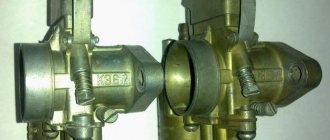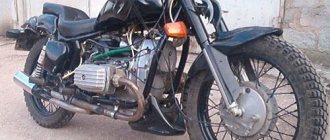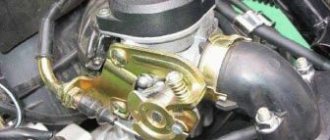Set the correct sag using spring preload.
The sag can be adjusted in any conditions, including immediately before departure. Please note that the condition of the suspension can greatly affect the measurements. When taking measurements, do not “plop down” on the motorcycle, do everything smoothly and carefully.
Using a tape measure and clamp, take measurements:
| The fork is fully extended. Lift the motorcycle onto a motocross stand or stool. Do not use tackles; the front wheel of the motorcycle must be hanging out. Attach the clamp (plastic tie) to the fork leg close to the boot. | Motorcycle sag (static sag). Carefully lower the motorcycle from the motocross stand or stool. The distance by which the clamp or tie slides along the motorcycle fork leg will be the sag of the front fork of the motorcycle (static sag). | General sag. Take your normal position, sitting or standing on the motorcycle, with both feet on the pegs. Place your elbow on the wall or ask a friend to help you hold the bike. The total distance that the clamp or tie will slide is the total sag. |
Front total sag value: Check your motorcycle manual for the full fork travel value. The overall sag of the motorcycle should be about 33% of the full fork travel .
Use a tape measure. Don't "plop" on the motorcycle.
Measurement 1. The rear shock absorber is fully extended.
Lift the motorcycle onto a motocross stand or stool. Do not use tackles; the rear wheel of the motorcycle must be hanging out. Measure the length of a vertical line from the center of the rear wheel axle to the mark on the plastic of the motorcycle or exhaust pipe with a piece of duct tape.
Dimension 2. Motorcycle sag (static sag).
Carefully lower the motorcycle from the motocross stand or stool. Re-measure. The difference between the first and second measurements will be the static rear sag of the motorcycle.
Dimension 3. Total sag.
Take your normal position, sitting or standing on the motorcycle, with both feet on the pegs. Place your elbow on the wall or ask a friend to help you hold the bike. Re-measure. The difference between the first and third dimensions will be the total rear sag of the motorcycle.
Rear total sag value: Check your motorcycle manual for the total rear shock travel value. The overall sag of the motorcycle should be about 33% of the full rear shock travel .
Basic theoretical principles of motorcycle suspension adjustment, types of adjustments
Cars No comments » Dec 16, 2020
I am not a professional motorcyclist and do not claim to be a guru in the field of motorcycle suspension tuning. There is a lot of detailed information on the Internet on tuning the fork and rear shock absorber of an off-road or road motorcycle. But below I described everything as concisely and clearly as possible , so that there would be a specific idea of how to adjust the suspension, what the adjusting screws are responsible for, and how the motorcycle will behave at different settings. You can say this is a simple manual on your fingers for dummies , just what beginners need. Knowledge that once helped me understand...
First, find in the motorcycle manual or on the Internet which screws on the suspension are responsible for what . Usually there are 2 of them on the fork and on the rear shock absorber - Rebound and Compression .
Having decided on the purpose of the screws, think about how long ago the suspension was serviced . Ideally, overhauling and changing oil in the suspension should be done once a season, but it also depends on the riding activity and purpose of the motorcycle. If the maintenance was carried out a long time ago, then the adjustment will not give much result.
Having serviced the suspension, start adjusting... You need to do it sequentially , first one then the other. Don't try to rotate both compression and rebound at the same time. Before adjusting, unscrew everything to the edge that releases the adjustment, i.e. for maximum softness, unscrew, and tighten one click or small turn at a time during adjustment until an optimal comfortable ride, or even better, to the parameters recommended by the factory, taking into account the weight of the rider.
Compression adjustment
With this screw you adjust the ease of compression of the suspension at a low speed of compression of the suspension (a tautology, but it is true). That is, for example, when you are not driving fast over low hillocks, will the suspension react or not? (usually a screw at the bottom side) Tighten the compression (tighten) - there will be shaking, a stiff suspension and loss of wheel holder. Release the compression (unscrew it) - it will be very soft, but at speed or high obstacles the suspension will “punch through”. But how quickly and easily the suspension will compress at high compression speeds (i.e. sharp and rapid pressure on the suspension) depends on the valve washers in the suspension. These washers are replaced with others during maintenance for the required result. On an advanced suspension, such adjustment can also be made to the screw.
Rebound adjustment
With this screw you adjust how quickly the suspension will expand . (usually the screw is at the top) Release the release (unscrew) - it quickly opens, the wheel holder disappears. Press the release button (tighten it) - it slowly unclenches, the steering wheel “clogs” and the wheels jump. He will beat you, including hitting you in the hands.
How many clicks or turns should you turn for the suspension settings to be optimal? First of all, as much as indicated in the instructions from the manufacturer . If there is no such information, then you can try to take the settings from a similar motorcycle with the same suspension and adjust + - for yourself. If there is no such information, then, as I wrote above, first unscrew the settings to maximum softness and gradually tighten them until you achieve that the suspension does not sway or jump over uneven surfaces , does not skid and is comfortable.
I deliberately omit many details in this article so as not to load it with unnecessary information, especially that which I myself do not fully understand. For example, pre-compression of the spring, and other little things. But I’m sure the information above is enough for any beginner to immediately understand what’s what










